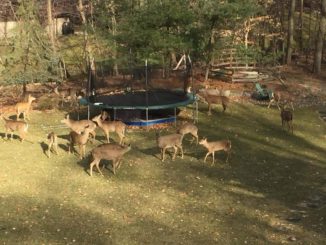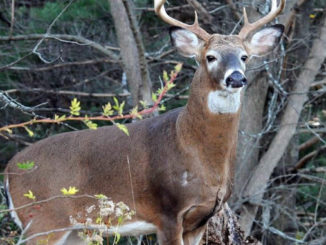
BY MICHAEL OLOHAN
OF PASCACK PRESS
RIVER VALE, N.J.—Township officials were provided with a range of non-lethal deer management strategies by an animal rights group Jan. 28, but the non-lethal control strategy it recommends is not yet approved by state officials—who ultimately must approve River Vale’s deer management plan.
Mayor Glen Jasionowski later called the non-lethal deer control methods described “very informative” and said council members need to discuss both lethal and non-lethal methods at a work session and make a decision soon.
He noted that if hunting were to be the method selected by council members, a hunt would include professional bowhunters regulated closely and only on the township’s golf courses, not residential properties.
Deer population control became a hot topic after Jasionowski—who previously opposed hunting—called for a deer hunt at a mayors’ forum in October 2018, citing an increasing number of deer-vehicle incidents in 2018.
Following pushback from animal activists, Jasionowski and council members solicited presentations from state Fish and Wildlife biologists and Animal Protection League of New Jersey representatives to hear out both sides of the issue.
State officials appeared Dec. 10, 2018, and called a regulated deer hunt involving professional hunters “the most effective way to manage deer” and urged council members to act soon to prepare for a 2019 hunt.
Non-lethal methods
Approximately 50 residents listened Jan. 28 to a 30-minute non-lethal presentation from Animal Protection League of New Jersey on deer biology, state deer population, why hunting fails to control deer population, and deers’ preference for ‘edge habitat’ between forest and open space—areas amply provided on the township’s three golf courses and townhome developments.
Doris Lin, the League’s director of legal and government affairs, provided information on several non-lethal deer control and population control strategies, including a few low-cost efforts that local officials appeared interested in implementing such as road reflectors wrapped in white cloth to resemble a deer’s raised tail.
This helps to act as a warning to other deer to avoid a busy roadway, Lin said.
Following Lin’s presentation, council members questions zeroed in on data supporting the League’s deer population control options—including surgical sterilization of does by a procedure called an ovariectomy—where a veterinarian removes a female deer’s ovaries to prevent pregnancy.
Lin estimated the procedure at a cost-per-deer of $1,000 to $1,200.
Moreover, Lin told members that Saddle River had proposed such a non-lethal plan recently to use ovariectomies to control deer population and the state Fish and Game Council rejected their proposal.
The state agency must review and approval local deer population control plans, she said.
Lin said the Saddle River plan was rejected for two reasons by the state Fish & Game Council, which currently only lists two approved non-lethal options: trap and transfer and chemical sterilization.
The state rejected Saddle River’s surgical sterilization proposal noting a plan cannot be both a plan to reduce population and determine population impacts and that other states’ fertility research programs show “low expectations of successfully reducing deer in an open population or reducing human-deer conflicts in a timely or cost-efficient manner.”
Lin said private donations were lined up to underwrite the cost of Saddle River’s sterilization proposal, although a couple River Vale council members noted funding in River Vale may be an obstacle to that non-lethal method.
One non-lethal approved
Lin said she was aware of only one non-lethal plan being approved by state officials, in Princeton, and said it was successful but ended.
Other non-lethal deer population control methods she mentioned included immunocontraception being used in Hastings-on-Hudson, N.Y. and male deer vasectomies being used in Staten Island, N.Y. She said costs were much higher for both non-lethal methods.
She repeatedly said the two state agencies who currently do not permit surgical sterilization as a non-lethal deer reduction option—the Fish and Game Council and NJDEP Division of Fish and Wildlife—get partial funding from hunting license revenues “and have a strong bias towards hunting.”
She urged council members to lobby state Fish & Game members to include surgical sterilization and should that fail, file a lawsuit against the state.
Township Attorney Silvana Raso did not see a basis for such a lawsuit, though Lin, an attorney, offered to assist in the efforts.
Local deer ‘capacity’
Asked by council President Mark Bromberg if she knew either River Vale’s biological carrying capacity or cultural carrying capacity for deer, Lin said she did not. She said both terms may be used to define an area’s ability to support deer.
Several council members asked Lin for specific data, including local deer population, possible volunteers to assist non-lethal efforts, and statistics on hunting accidents.
She said nationwide 100 people are killed yearly in hunting accidents but had no local deer numbers.
She said the state only uses “cultural carrying capacity” defined as an area’s residents comfort level with local deer population.
The term “biological carrying capacity” refers to what number of deer a certain area can support without harming the native plants, forest understory, or causing negative ecosystem impacts.
Common deer ‘myths’
Lin highlighted some deer “myths” noting that deer-car accidents do not increase during the “rut” or mating season but as a result of hunters walking in a row across fields to drive deer out of a field when hunting season begins.
She said Lyme disease is not spread by deers alone but other tick hosts including mice, where the tick actually picks up Lyme disease, often before it attaches itself to a larger host animal.
“Hunters endanger the entire community,” she said at one point, calling hunting “a failed experiment” because the state indicates on wildlife maps “we still have a high deer population.”
Jasionowski said River Vale has seen a dramatic increase in vehicle-deer incidents in the non-mating season, and not the rut or mating season mid-November through December.
He told Lin his biggest concern is someone gets killed by a deer-vehicle collision. He said the township is already seeing does giving birth to triplets. Lin suggested that may be due to the area’s abundant landscaping.
Asked about further studies on non-lethal methods, Lin suggested visiting deerfriendly.com for more current data on non-lethal options for deer population control.
A regional issue
While the issue of deer population control has grabbed attention lately in Pascack Valley and Northern Valley towns where deer are often a common daily sight, only Saddle River has begun a regulated bowhunt to reduce deer population.
That culling effort reportedly reduced Saddle River’s deer population by 90 deer, according to published reports.
Council members said afterwards they hope to gather all studies and data from state officials and animal activists—along with police data on accidents and incidents—and make a decision. Jasionowski said he would also reach out to Saddle River’s mayor to learn more about that bowhunting program.
An information flyer provided on a rear table offered seven tips to avoid a deer-car collision, noting a federal highway safety agency reports an average 187 fatalities annually due to large animal-vehicle collisions.
Accident avoidance tips include: slowing down; wearing a seat belt; watching for deer; using high beams for visibility when no oncoming traffic appears; blasting the horn to scare animals out of the road; being aware of animal activity signage; and, if possible, driving in a center lane to give grazing animals extra space.


